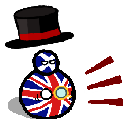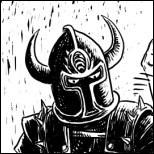|
A friend just approached me about playing SAGA so I printed out a whole warband of Persians.  (Not the whole warband.) These March to Hell figures are extremely good and cool, but you absolutely need to scale the X and Y to 85% or bring the Z up to 118% to get rid of their weird Fisher Price stylizing. Which also means you can't use the pre-supports, but eh.
|
|
|
|

|
| # ? May 24, 2024 07:17 |
|
The pre-supports aren't great, so you don't lose a lot. I think the dimensions are fine in 15mm, at least - they're blocky and, importantly, hold up to handling much better than some of the realistic figures I've used. But in 28mm they just look terrible without that sort of fix.
|
|
|
|
They're kind of perfect in 15mm - you get enough visual information to read what's going on and the prints are more sturdy than a lot of others.
|
|
|
|
I finished the Martinstaat 1744 book and my lord, what a book. I've immediately gone out to order his Campaigns and Compendium books off the back of the strength of this one. He did a fantastic interview with Little Wars TV which put him on my horizon in a meaningful way: https://littlewarsfm.podbean.com/e/wargaming-campaigns-with-henry-hyde/ but it's only after reading his work I realise how much I feel a parallel in his own actions and my desired way of gaming! A large part of the book is his notes from the campaign diary (pictures of which I showed earlier) which detail from the perspective of a C-in-C the process of the campaign system. I won't spoil anything for those who want to read the book, but the Martinstaat 1744 campaign was the third in a series with Henry and his friends, and part of a much larger imagination world stretching into the past and towards our present. He uses fairly in-depth rules for his campaigns, or should I say - he has invented rules to fit into areas where there is a need to flush out ambiguity, and the entire corpus ends up being in-depth. He freely admits that the more modern frameworks provided by himself in Campaigns (and IMO the William Sylvester Solo Wargaming book) may be superior, but very deliberately includes what he actually used - rather than some idealistic perfect set of rules. Similarly, he is using Newbury wargaming rules and even in the diary itself bemoans how turgid they are - but he DOES play the games. One of the most striking things from the book is how little the actual tabletop wargame factors in - of course there are about half a dozen battles from small skirmishes to giant sieges and set piece battles - but he views them as a combined and complementary pairing to the campaign rules, rather than the campaign only providing a context for the games. I think this is because he operates with a true fog of war system - both commanders have parameters for movement and simply exchange grid coordinates - it's only when units pass adjacent or into each other that something is revealed. A such, feint and counterpunch, the use of scouts and reconnaissance, etc. is an active part of the campaign decision making process, rather than simply trudging your deathball of troops and their block of troops. I have managed to convince myself to 'finish' the ECW forces that I have knocking around before I embark on another painting project, though*. On the workbench are ~twenty casualties Pendraken - 20p each, versus Warlord - £1 each), a herd of cattle (just remember, mostly brown!). I have some pigs and I'll also need to set up some hedging for aforementioned livestock, too. And two more bases of cuirassiers. And some artillery horse teams. THEN I'm done. * I did say no more PAINTING projects...  EDIT: I'm fairly certain I want to stick with 10mm, though annoyingly the Henry Turner figures when scaled to 10mm the four-man strips don't fit nicely onto either 1", 2" or 40mm wide bases, blast it! Southern Heel fucked around with this message at 13:38 on Aug 14, 2023 |
|
|
|
Southern Heel posted:I finished the Martinstaat 1744 book and my lord, what a book. Sounds pretty great actually, I might have to check some of his stuff out. Is it two players and an umpire or something else?
|
|
|
|
QUESTION: Whenever I see a big battle display or game, there are always multiple battle lines. This is something which is described often in real life (a la British managing to fight off a French attack column, only to find another coming up behind, wreathed in smoke) - but I don't really understand how games can facilitate it. Lots of rules don't permit interpenetration, penalise movement to the rear, and emphasise panic in fleeing/routed units - so it would seem the most prudent thing to do would be to string your lines out as wide as possible. Has anyone managed this in a non-club game setting? How? QUESTION: What I would like to know is more the meta-campaign (gosh, how many levels?), specifically how to generate a campaign map which has meaningful choice in terms of routes and division of forces. That should hopefully lead naturally to how to determine fun and realistic campaign goals for both sides. Both of these things have somewhat flummoxed my two attempts to date. INinja132 posted:Sounds pretty great actually, I might have to check some of his stuff out. Is it two players and an umpire or something else? This particular book isn’t a ruleset, it’s a campaign diary of a series of games he played with his friend - it covers the world background, the campaign rules and map, the movements and sequence of events, some tabletop games - and lots of art, maps and photographs. Henry has written his own rules (sword and stone?) but in this book he's using some old-school 'Newbury' rules from the 1970's. His particular campaign ruleset in this book is definitely a product of its time and is improved in his Wargames Campaigns book, and in a more streamlined form of parallel evolution in Solo Wargaming. Specifics here he plays both an umpire and player: movement is hidden so no major conflict there. He does solo game small/one-sided battles since his opponent is some distance away, saving the big and interesting conflicts for face to face. I really like Henry's use of scouts - essentially pushing back the fog of war for each army. I don't have his exact rules for scouting, but it appears that a scout coming upon an enemy only reveals the SIZE of the opposing army and the troop types therein, as opposed to its exact disposition. It also appears that armies can choose to try to force a battle, stand their ground, or retreat - rather than always ending up smashing into each other. EDIT: Sorry, I have realised I just assumed you were thinking this was a ruleset. Hopefully this is useful for you or anyone else reading the thread. Southern Heel fucked around with this message at 10:32 on Aug 15, 2023 |
|
|
|
It's not exactly historical but Kings of War makes multiple lines work just fine because units that break and run just disappear, having scattered to the four winds.
|
|
|
|
Some allow it, I know in Blucher interpenetration is legal so long as you don't end your movement on a friendly unit. If you haven't check out his Scharnhorst campaign system in there, it has map movement and rules for breaking up opposing forces into columns who are trying to recon, evade, or destroy each other.
|
|
|
|
spectralent posted:Same, but then, I'm usually putting them together to make tanks for CoC so I don't need to make sixty of them. Honestly I feel like one of the biggest issues is just the fact you're making soviet tanks which, for stupid reasons, are things you have to make in batches of twenty instead of making an army with like 10 tanks and calling it good like everyone else gets to.
|
|
|
|
Southern Heel posted:QUESTION: Whenever I see a big battle display or game, there are always multiple battle lines. This is something which is described often in real life (a la British managing to fight off a French attack column, only to find another coming up behind, wreathed in smoke) - but I don't really understand how games can facilitate it. Lots of rules don't permit interpenetration, penalise movement to the rear, and emphasise panic in fleeing/routed units - so it would seem the most prudent thing to do would be to string your lines out as wide as possible. Has anyone managed this in a non-club game setting? How? afaik the "old school" solution is to have bonuses to either combat or morale based on how well a unit is "supported", with having a second line behind being one such way of being supported. As mentioned a solution is to have rules where broken units are simply removed.
|
|
|
|
This is a playtest of a system I’ve been working up which converts the excellent Lasalle rules to the First World War. To my knowledge there are only two popular WW1 rulesets: Spearhead (which I don’t really like) and Square Bashing (which looks alright but not really what I’m interested in right now). As such I thought I’d give it a go modifying Lasalle as its core is so strong. This AAR covers the third playtest of the mod and sees the British assaulting an unprepared German position anchored on a hill-top town in 1914. This is scenario 4 in the Lasalle Rulebook: “Making the Omelette”. The town is worth 2 VPs, with the gap between the town and the nearby woods worth 1. I played the British and my opponent the Germans. For those unfamiliar with Lasalle, units are moved and organised in battalions of four bases (one per company in this game) which belong to a brigade. Some orders go straight to the brigade and can be done by any units of that brigade which are close enough together and others are “global” allowing any unit to do it. The two-based artillery here represent a battery of field guns. Ignore all of the numbers and such on the labels, we were just using them for tracking losses. My mod has no points system currently so I just sort of winged the two forces. The Germans set up first and have two infantry brigades with a battery of artillery attached to each. They also have a third cavalry “brigade” consisting of a single regiment of cavalry. They anchor their left flank on a convenient right-angled wood block with one brigade holding the edge of the treeline:  Their right is on the hill-top town with another brigade in position, two battalions forwards and one in reserve. The cavalry hold the extreme right flank:  The Germans are regular infantry, meaning they are disrupted on a 4+ and rally on a 4+ if the enemy is near to them (“Near” = 4 Base Widths = 12cm in this game). Their main advantage is in the quantity of Machine Guns attached to each Battalion, which can be used either for extra dice or to improve the rolls of the unit (hence no actual Machine Gun units are played). In this version the Germans have 3 MG “points” in each Battalion compared to the British 1. The Germans are in unprepared positions here (although they do receive cover from the hill and the forest) but if I was fighting this battle again I would have had them deploy in trenches I think.  The British have a full division of three infantry brigades at their disposal, plus four batteries of guns. In retrospect this was possibly a bit much but balance is always the hardest part with these things. The British deploy in an off-balanced formation. On their left they deploy two of their three brigades in order to launch a massed assault against the hilltop:  On the right they deploy a single brigade to “fix” the Germans in the forest. The hope is to therefore achieve a 2:1 advantage against the Germans in town and drive them out, potentially at some cost:  The artillery deploys as one force in the centre, with three batteries supporting the attack on the town and one supporting the opposite flank to try and suppress the German artillery:   Turn 1 The British advance forwards on the left with minimal engagements, the range still being considerable:  On the right the British line holds but during the artillery battle the Germans are able to temporarily drive off a battery of British guns:  These guns recover at the end of the turn with no loss and return to the battlefield. (Note: this is a fairly major change from normal Lasalle. In the mod units which are driven off with Disruption (i.e. temporary hits) get to roll at the end of the turn for each hit. If they rally at least some of them, they can rejoin the battle as reinforcements. This is intended to simulate that in this period units tend to recover and reorganise more quickly than in the Napoleonic era and can rejoin the fight more rapidly, albeit often at some loss). Turn 2 The British advance on their left continues. The Germans decide to bring up their reserve battalion in the woods to the front in an assault formation. The British respond by moving their reserve battalion to cover the flank in case the Germans try to sneak round and remove two momentum for destroying the baggage:  Other than some ineffective artillery fire both ways this is all the action the British right / German left flank saw in this battle and the matter was decided elsewhere. The British brigade had achieved their objective of fixing the Germans, who were too far away from the opposite flank to provide support. Turn 3 The British left closed to within 800 yards of the German position on the hill, deploying into a skirmish line to try and cause some attrition with their Machine Guns. British artillery drives an entire German battalion on the hill off the field of battle, forcing the reserve to move forwards and steady the line. The German cavalry also dismounts and deploys into a rifle line:  Turn 4 The British shooting proves superior and they cause major loss to the Germans, even with the terrain benefit. In response the Germans struggle to cause any permanent damage to the high-morale British forces. The order is given to form up into assault formations and launch the attack as the German garrison prepares their defences:  Turn 5 The attack goes in! In the centre the two British battalions annihilate the German half battalion remaining in the town, leaving them only a single half-company strong when they are re-organised:  The British battalion on the far left flank also charges the cavalry… only to be turned away and driven back by rifle fire!  Some fortunate rally rolls for the Brits mean that across the front permanent casualties are slight although they are certainly shocked by the stubbornness of the German cavalry, whose fire to that point had been desultory. Turn 6 Now in control of the town, The British are able to drive off the remaining German battalion and the German guns decide to quit their position and beat a hasty retreat! The Germans are finally able to inflict some losses on the British, but with the cavalry being destroyed in a second charge, the possibility of a counter-attack is slim. As such, the British claim the day.  Overall the system worked pretty well. Units moved and behaved broadly as expected and it was certainly fun to play, although that’s likely down to the Lasalle system being so good! The British were probably over-egged somewhat, potentially not needing both the 5+ the Germans needed to Disrupt and the 3+ rally, which meant actually inflicting any loss was very difficult (certainly too difficult for the First World War). In future 4+ to hit will probably be used, with the 3+ for the Old Contemptibles rallying ability being kept (based on their performance particularly at 1st Ypres). The Germans did also have some poor rolling which never helps in these kinds of things so I’m not going to be overreacting too much with any changes. Their benefit in machine guns probably didn’t balance out quite with the British, and more importantly the 2:1 British advantage in guns was fairly decisive. The points cost of artillery will need careful consideration when playing without defences. As mentioned above, giving the Germans some trenches to defend (completely reasonable in this era) would have made a big difference as the British would only be hitting on 6s rather than 5s (for the crest cover).   
|
|
|
|
This project sounds fascinating, but is there a thought to how you'll be handling the static and multilayered trench systems characteristic of the later war? My understanding, which might well be wrong entirely, is that Lasalle like a lot of movement (and indeed, has things like baggage capturable), whereas as we know, WW1 came to be characterised by the impossibility of flanking and manuever and the unreachable nature of any important objectives which could never quite be captured before momentum petered out. Granted, that does sound miserable, but it also feels like something the rules would need.
spectralent fucked around with this message at 17:41 on Aug 15, 2023 |
|
|
|
nice implementation of that polycarbonate sheet tabletop. i used that for my 2mm naps but looks like 6 mm works well (that's 6 right?)
|
|
|
|
That post (which looks really cool! Keep us updated!) Got me looking into Square Bashing which got me thinking... What are the best gunpowder-or-later games that fit on a 3x4 or smaller table? I have a small apartment and currently enjoy Forbidden Psalm, a fantasy game that plays on a 2x2 mat, and I'd love to find something historical to play on a dinner table. Playing the Marne on a 6x8 table is great but I just can't! I'm also eyeing Fireball Forward which plays on a small mat.
|
|
|
|
Thank you re: ideas about multiple lines. I got my head down last night and got most of those two pike and shot battalia done, but overall I'm still probably a little short on bases for my ECW to be able to support two armies which have multiple battle lines and I'm considering that project mostly finished for now. Not at all because I have a new obsession with the 7YW, honest! INinja132 posted:This is a playtest of a system I’ve been working up which converts the excellent Lasalle rules to the First World War. To my knowledge there are only two popular WW1 rulesets: Spearhead (which I don’t really like) and Square Bashing (which looks alright but not really what I’m interested in right now). As such I thought I’d give it a go modifying Lasalle as its core is so strong. Owns! Count Thrashula posted:What are the best gunpowder-or-later games that fit on a 3x4 or smaller table? I like chewing on ideas as much as the next but this feels like a bit of a softball! Pretty much any 28mm ruleset cut down to half ranges/base sizes. Absolute Emperor is designed for forces deployed no further than cannon range apart (18"?) and can be either Army or Division-scale with a few built-in tweaks. DBN is also designed for boards 2x2 up to 3x4'. I am absolutely all about loving with ranges, scales and base sizes though, so that may tilt my perspective somewhat. Given how fudged game-scale is anyway with more recent rules not even bothering with a figure:person ratio I don't see it as a major issue. I still absolutely need to get a few games to the table, but while I'm able to sneak in 15-20 minutes here and there for painting, dedicating an uninterrupted block of 2-3 hours for wargaming is a bit more tough - particularly when it has to commence after 8-9pm and generally has to be torn down before the next day. I'm trying to figure out how to get a 3x4 or 3x5 table in my office with precious little success so far... Anyway, here's a nice video about the Joy of Six convention: https://www.youtube.com/watch?v=uK11EgsNugA
|
|
|
|
Southern Heel posted:QUESTION: Whenever I see a big battle display or game, there are always multiple battle lines. This is something which is described often in real life (a la British managing to fight off a French attack column, only to find another coming up behind, wreathed in smoke) - but I don't really understand how games can facilitate it. Lots of rules don't permit interpenetration, penalise movement to the rear, and emphasise panic in fleeing/routed units - so it would seem the most prudent thing to do would be to string your lines out as wide as possible. Has anyone managed this in a non-club game setting? How? Most games really struggle to show the issues with maneuvering long lines in such a way without them losing cohesion, just from a physical standpoint. Mechanically, you'd have to do something like have units move to a destination then randomly roll for how far they go which is really awkward. Basically, it's almost impossible to keep hugely long lines as a coherent line for very long at all, which is why columns of line existed- it's just more maneuverable, which is important if you're trying to march to contact. And yeah the formations in general in pre-modern warfare were spread out more than art tends to depict. In fact this was an issue in Total War games, too, before they just kinda gave up on modeling and let even deep blocks have everyone shoot if someone's in range- the optimal formation was always as long and thin as possible.
|
|
|
|
Chain of Command, weirdly, kind of does that, because of how shock can apply to separate teams it's possible to have one team move slower, even a LOT slower, than another, and require the whole group to slow down to keep cohesion.
|
|
|
|
Sharp Practice and Pickett's Charge both model it pretty well. Both have rules for interpenetration of lines, too
|
|
|
|
Multiple lines are often indirectly handled by having a scenario that uses reenforcements on subsequent turns of play. I.e., the stuff that starts on-board is the first line, the stuff that shows up on turn 3 is going to be the next line, etc.
|
|
|
|
With the two rear battalia (black moons and blue stripes) my ECW force is complete. There are technically a couple of forlorn hope and artillery teams but I'm calling time on this: Although slightly cheating because it's 10mm, it's definitely the highest figure count of any army I've put together with about 360 figures total and something like a 1:20 figure ratio for typical company sizes of the time AFAIK. All the figures are Pendraken, 90% painted with contrast paints (grey undercoat, white drybrush) and then glued to MDF bases and Vallejo European Mud splattered on them. You can't really complain at the price and quality Pendraken offer! On the negative side, I wish in retrospect I had gone with 40x20mm basing for everything - those pike blocks look just a bit on the small side IMO because they're on 40x30mm bases. I'm also a bit sad there's basically no way to expand the army without essentially duplicating what I've got here. I'm not that interested in getting the Scots involved, and so it'll just be more of the same three unit types. I guess that is something to bear in mind for the next project? I really can't see much in it from a game perspective between the SYW and Napoleonic periods - musketry is slightly more effective, cavalry charges are slightly less effective, light cavalry is mostly used for flanking and harassing, and guns are more distirbuted through the armies. It seems the common misconception of extremely slow armies consisting only of giant lines of musketeers is as mythologised as the idea of WW1 being entirely about stagnant siege warfare. I'm not going to paint myself into a corner by starting up a 7YW force in the way I feel with my ECW armies, am I? Southern Heel fucked around with this message at 15:54 on Aug 16, 2023 |
|
|
|
Watching Master and Commander again atm someone please tell me why I shouldn’t spend all my disposable income on tiny boats
|
|
|
|
Edgar Allen Ho posted:Watching Master and Commander again atm someone please tell me why I shouldn’t spend all my disposable income on tiny boats Spend only a portion of it with Tumbling Dice: https://tumblingdiceuk.com/collections/1-2400-naval-napoleonic
|
|
|
|
Different era, but - yes, buy tiny boats.
|
|
|
|
tiny boats freaking rule
|
|
|
|
Edgar Allen Ho posted:Watching Master and Commander again atm someone please tell me why I shouldn’t spend all my disposable income on tiny boats Blood and Plunder is great, and the two player starter is a great value!
|
|
|
|
Painted up some 1/2400 Napoleonic boats about a year ago. I need to do more! They're fun and easy.
|
|
|
|
hot cocoa on the couch posted:tiny boats freaking rule
|
|
|
|
hot cocoa on the couch posted:tiny boats freaking rule
|
|
|
|
hot cocoa on the couch posted:nice implementation of that polycarbonate sheet tabletop. i used that for my 2mm naps but looks like 6 mm works well (that's 6 right?) Thanks! I originally did it for 3mm Napoleonics but it's fine for 6mm as well (it is indeed, good eye). At some point I could do with a blind on those windows to stop the crazy glare. spectralent posted:This project sounds fascinating, but is there a thought to how you'll be handling the static and multilayered trench systems characteristic of the later war? My understanding, which might well be wrong entirely, is that Lasalle like a lot of movement (and indeed, has things like baggage capturable), whereas as we know, WW1 came to be characterised by the impossibility of flanking and manuever and the unreachable nature of any important objectives which could never quite be captured before momentum petered out. Granted, that does sound miserable, but it also feels like something the rules would need. At the moment I'm just looking at early-war stuff where there's still plenty of movement but you're definitely right that it would require much more adaptation to get into proper trench warfare. If I want a true conversion to WW1 I'm going to have to dive into trench-lines at some point but I'm currently content that it may just be the wrong system for that. Maybe when I've determined rules for heavy artillery and aircraft that will pave the way. Count Thrashula posted:That post (which looks really cool! Keep us updated!) Got me looking into Square Bashing which got me thinking... Ironically Lasalle is great for this! The table size is scaled to base-width, so if you play with 30mm wide bases for example (as I do for both 3mm Naps and 6mm WW1) then per the rulebook your table will be 1080mm x 720mm (approximately 3.5 x 2.4 ft). I tend to play on a larger table than that because I like having a bit more room for manoeuvre and a bigger table works better for WW1 I think as well. My board is around 5x3 so around half as dense as recommended width-wise but I can't say I've ever thought it was a problem. Lots of incredible tiny boats (and massive ECW armies) on this page!
|
|
|
|
Talking of table sizes, I've just decided to replace using the end of my dining table downstairs, with a 3x3' folding table in my office. My hope is that this will reduce the motivational friction of having to select and cart downstairs all my figures, scenery, rulebooks, etc. which I think is partly the cause of not actually getting games on the table as often as I would like. It should also hopefully make battle reports/etc. easier and more enjoyable to produce. The change in location does have me thinking about size, though. Though I don't play skirmish-level games at the moment, I reckon that 3x3' is probably quite sufficient for them.While I've never actually had problems playing massed battle games on my 3x3' board, received wisdom would suggest that bigger is better, and I can just barely fit another 3x3' board adjacent if necessary. Is it worth it, though? - In terms of board depth being a factor, one can start units off-table (either directly or with an offset which is decremented) and must move toward the front lines - In terms of board width, one can either abstract the wings of a battle, or plan out the overall deployment across x boards, then fight the battle separately in sequence. I guess the one big thing that's missing is the 'big battle' feel that only comes from having lots of figures on the table, but only very little (see above re: wings/centre) lost from a mechanical perspective. I would appreciate any thoughts or feedback....
|
|
|
|
Southern Heel posted:
Which dimension is the problem? As in, could you get an extra 2x3 table and have a combined 5x3 board or would it still be too much of a squeeze? Alternatively could you have one permanent 3x3 which you use most of the time, and then crack out the second table for special occasions? I think you probably would lose something for large battles even with your mitigations but if the alternative is no gaming I'm sure you can make it work on a 3x3. You might even be able to write a book about gaming on a half sized table!
|
|
|
|
INinja132 posted:Which dimension is the problem? As in, could you get an extra 2x3 table and have a combined 5x3 board or would it still be too much of a squeeze? Alternatively could you have one permanent 3x3 which you use most of the time, and then crack out the second table for special occasions? I'm not worried about the distance between armies particularly, I'm mostly considering the length of the table being a factor. It's an absolutely moot point at the moment since I don't even remotely have enough figures that I have to worry about the wings as independent units in battle - but maybe I should get a second table just so I can be sure they're the same height/etc.  When you want to be absolutely sure you're picking the right game scale: 6mm (sixteen per base) > 10mm (twelve per base) > 15mm (eight per base), 20mm (three per base - one omitted for clarity) > 28mm (two per base). Lets gooooooooo Southern Heel fucked around with this message at 14:58 on Aug 17, 2023 |
|
|
|
which ww2 miniature game would have proper realistic rules for artillery where it causes the most casualties?
|
|
|
|
ChubbyChecker posted:which ww2 miniature game would have proper realistic rules for artillery where it causes the most casualties? depends on how you view "casualties". cause if it's removing figs/stands, that mioght not be a great metric. artillery in games is usually represented best at the regimental/divisional level and up, like in bkc and rommel and such. otherwise you just have some nebulous offboard artillery strike pre-game type thing that usually isn't really realistic (esp because most games at platoon or company scale put the fire mission well inside the "danger close" firing range, which most commanders would be hesitant to request, to say the least). or silly poo poo like tubes being on-board like in flames of war. but artillery reducing the effectiveness of fighting groups (by causing casualties/morale hits in game mechanics), and then infantry/armour sweeping them away with an assault (by disintegrating units as fighting groups/removing stands in game) is realistic in higher level games like mentioned above, even if you don't record "casualties caused"
|
|
|
|
basically my view is that artillery causing hits and softening units is a realistic portrayal of the casualties they sustain, and then "teeth" arm units assaulting and removing the units from the game more represents destroying their effective organization, not necessarily that they hurt/killed more dudes
|
|
|
|
ChubbyChecker posted:which ww2 miniature game would have proper realistic rules for artillery where it causes the most casualties? That's going to be hard to make an interesting tactical game out of, because wargamers like to feel like they have a fair chance at winning. Artillery causes casualties in a completely unfair manner - it kills people when they can't shoot back or don't even know they're in combat. In fact, that's the whole point of artillery. Imagine this as a tabletop scenario. Your goal is to move from one side of the map to the other. You set up your troops and start moving. The other player - who has no models on the board - just lays down templates, rolls dice, and you remove your models from the board. Once you get to the other side you count how many you have left. Here's another scenario. You set up your troops in the middle of the map. Your opponent - again, with no models - drops templates on them for a few turns, while you roll to see how quickly you can dig foxholes. Then you count survivors. These situations are not going to make for fun games, but that's exactly how artillery works in real life. The wargame conceit of artillery landing in the middle of a dramatic attack with tanks and artillery maneuvering nearby is something that's by far the exception. In reality artillery is all about shooting up an enemy who can't do anything about it.
|
|
|
|
You can kind of solve these problems at bigger-scale games - a game that had a surprisingly realistic element (though, of course, I stress element) is old 40k Epic. If a unit is "shooting" at something, that's some kind of artillery firing - stuff any smaller than an autocannon or a heavy bolter instead gets lumped into "assault" capability, which includes both hand-to-hand combat and also the short range firefights over objectives you'd expect to see in the kinds of tabletop wargames we tend to play. Which is honestly the best way to think about it - wargames are skipping to the "interesting bit" where you get your CO dropping grenades down artillery tubes or capturing airfields, not the terror-and-boredom bits of walking around and getting shelled that actually constitute most of winning a war.
|
|
|
|
Bit of an odd question with Battlefronts army books. Is there any point in getting the Soviet Book if I already own the Red Dawn one? The only thing of importance is the scenarios and the formations right? The latter of which are available online.
|
|
|
|
If you're planning on getting the online listbuilders then yeah, no, the value of the rulebooks in hardcopy is limited unless you're one of the factions with unique special rules. But also the soviets essentially don't get those, so yeah you're fine.
|
|
|
|

|
| # ? May 24, 2024 07:17 |
|
I've got some of the basecoats down for my 18th Century figures - seeing them in the flesh has been quite illuminating. I was half convinced that the 6mm figures might be a better shot, but in the flesh I don't think so. I'm not a massive fan of the Henry Turners at 15mm, the super-deformed look is not for me. The 20mm figures look nice, and I can fit six on a base, but the 28mm figures are way too big! As before, I've found the 10mm size is quite nice - fairly easy to paint when you're in the swing of things, etc. I decided to go with a fairly complex paintjob of blue coats, red facings and yellow stockings/waistcoat. In theory a Bavarian SYW regiment but in practise an imagi-nation.  spectralent posted:You can kind of solve these problems at bigger-scale games - a game that had a surprisingly realistic element (though, of course, I stress element) is old 40k Epic. If a unit is "shooting" at something, that's some kind of artillery firing - stuff any smaller than an autocannon or a heavy bolter instead gets lumped into "assault" capability, which includes both hand-to-hand combat and also the short range firefights over objectives you'd expect to see in the kinds of tabletop wargames we tend to play. This blew my mind initially - what do you _mean_ that my space marines only have a Missile Launcher? Aaaaahhh....
|
|
|



























